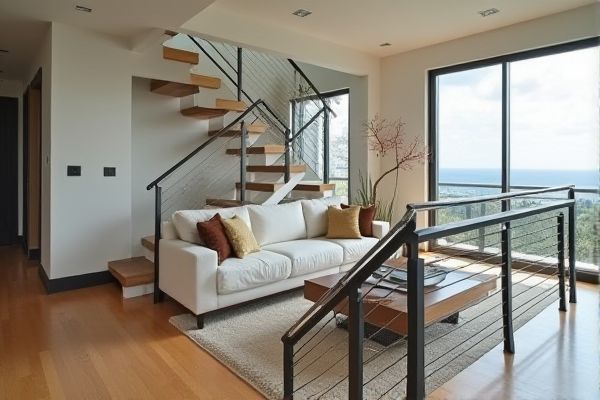
Steel railing offers unmatched strength and durability, making it ideal for security and heavy-duty applications, while cable railing provides a sleek, modern aesthetic with minimal visual obstruction and enhanced views. Discover which railing system best complements Your space by reading the rest of the article.
Table of Comparison
| Feature | Steel Railing | Cable Railing |
|---|---|---|
| Material | Wrought steel or stainless steel | Stainless steel cables with metal posts |
| Appearance | Solid, traditional, industrial look | Sleek, modern, minimalistic design |
| Durability | Highly durable, resistant to impacts | Durable, but cables may need periodic tension adjustments |
| Maintenance | Requires occasional painting or rust prevention | Low maintenance; occasional cable tightening and cleaning |
| Installation | Heavier, requires welding or bolting | Easier and quicker to install with tensioning hardware |
| Cost | Moderate to high depending on design and thickness | Moderate, varies with cable quality and system |
| Safety | Strong barrier, good for heavy impacts | Safe but cables can flex under heavy pressure |
| Use Case | Ideal for industrial, commercial, and traditional homes | Popular in modern homes, decks, and waterfront properties |
Introduction to Steel Railing vs Cable Railing
Steel railing offers superior strength and durability, making it ideal for both indoor and outdoor applications where long-lasting support is essential. Cable railing features sleek, horizontal or vertical stainless steel cables that provide an unobstructed view and a modern aesthetic, perfect for contemporary designs. Your choice between steel and cable railing depends on the balance you want between robust structure and visual openness for your space.
Materials and Construction Differences
Steel railings are typically manufactured from cold-rolled or galvanized steel, offering superior strength and durability with corrosion-resistant coatings for outdoor use. Cable railings use stainless steel cables strung tightly between posts, providing a modern, minimalist appearance with flexibility in design and easier installation. The construction of steel railings involves welding or bolting solid metal bars, while cable railings require precise tensioning of cables to ensure safety and stability.
Aesthetic Appeal and Design Flexibility
Steel railing offers a robust and classic aesthetic with its sleek, industrial look, providing strong design flexibility for modern and traditional settings. Cable railing delivers a minimalist and contemporary appearance, maximizing visibility and creating an open, airy feel that complements outdoor and interior spaces alike. Your choice between steel and cable railing will depend on whether you prioritize a solid, structured look or a chic, unobtrusive design.
Durability and Maintenance Requirements
Steel railings offer superior durability due to their resistance to impact, corrosion, and weathering when properly galvanized or powder-coated, making them ideal for long-term use in both residential and commercial settings. Cable railings, while sleek and modern, require regular tension adjustments and cleaning to prevent rust and maintain safety standards, especially in outdoor environments exposed to moisture. Steel's low maintenance needs and robust structural integrity make it a preferred choice for high-traffic areas where longevity and minimal upkeep are crucial.
Cost Comparison: Steel Railing vs Cable Railing
Steel railing typically costs between $25 and $50 per linear foot, offering a durable and strong option suitable for various architectural styles. Cable railing ranges from $50 to $75 per linear foot, reflecting its modern aesthetic and higher material and installation expenses. Your choice depends on budget priorities and desired design, with steel providing affordability and cable offering sleek, contemporary appeal.
Installation Process and Complexity
Steel railing installation involves welding or bolting steel components, requiring specialized tools and professional skills to ensure structural integrity and safety. Cable railing installation is generally less complex, using tensioned stainless steel cables threaded through posts, often allowing for quicker assembly with standard tools and minimal welding. Your choice depends on the installation expertise available and whether you prioritize a robust, heavy-duty framework or a streamlined, modern look with easier setup.
Safety and Code Compliance
Steel railing offers superior strength and durability, meeting stringent building codes and safety standards often required for residential and commercial projects. Cable railing, while visually lighter and modern, must be carefully installed with appropriate tension and spacing to comply with safety codes and prevent accidents, especially in areas prone to climbing or where child safety is a concern. Ensuring your railing system adheres to local regulations is essential for maintaining safety and avoiding costly code violations.
Outdoor vs Indoor Applications
Steel railing offers superior strength and durability for outdoor applications, resisting harsh weather conditions and providing long-lasting safety on decks, balconies, and staircases. Cable railing is favored for indoor settings due to its sleek, modern aesthetic and minimal visual obstruction, making it ideal for open-concept spaces and staircases. Both materials can be used indoors or outdoors, but stainless steel cables require regular tensioning and maintenance outdoors to prevent sagging.
Environmental Impact and Sustainability
Steel railing, made from recyclable materials, offers durability and longevity that reduce the need for frequent replacements, minimizing environmental waste. Cable railing features less material usage and allows for increased natural light, potentially lowering energy consumption within spaces. Your choice between steel and cable railing can influence sustainability efforts based on material sourcing and lifecycle impact.
Choosing the Right Railing for Your Project
Steel railing offers unmatched strength and durability, making it ideal for projects requiring robust safety features and long-lasting performance. Cable railing provides a sleek, modern aesthetic with minimal visual obstruction, perfect for enhancing views and open spaces while maintaining safety. Consider your project's design goals, maintenance preferences, and budget to choose the railing that best complements your space and meets your practical needs.
 homyna.com
homyna.com